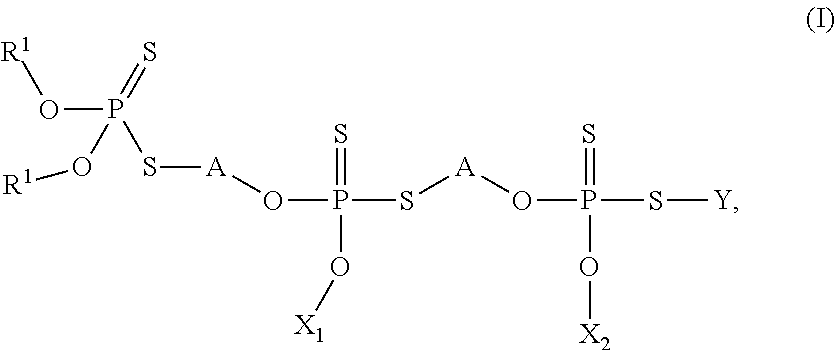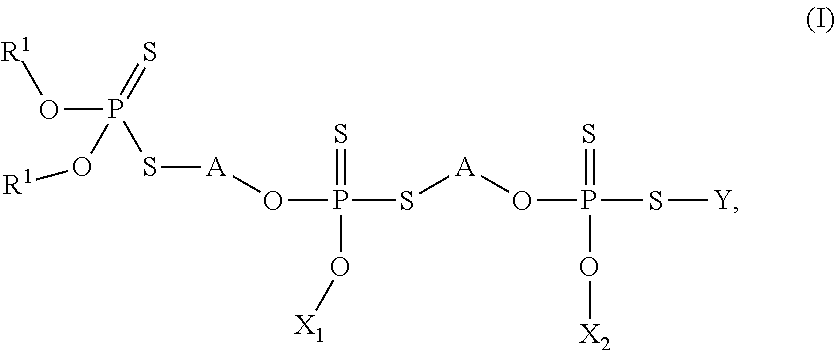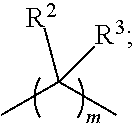Thiophosphates and thiophosphate derivatives as lubricant additives
a technology of thiophosphate and derivatives, which is applied in the field of phosphorous-containing compounds, can solve the problems of poor seal durability, reduced oxidative stability, and performance attributes that can suffer
- Summary
- Abstract
- Description
- Claims
- Application Information
AI Technical Summary
Benefits of technology
Problems solved by technology
Method used
Image
Examples
example 1
[0196]
[0197]Intermediate P1-A (600 g, 1.68 moles) was combined with O,O-di-isopropyl dithiophosphoric acid (180 g, 0.84 moles; used as supplied by Cheminova) in a round bottomed flask equipped with a magnetic stirring bar. The reaction contents were heated to 90° C. under reduced pressure (10 mm Hg). Throughout the reaction isopropanol was distilled off and collected into a separate cooled vessel. After 6.5 hours the reaction contents were cooled to 10° C. and propylene oxide (49 g, 0.84 moles; Sigma Aldrich) slowly added to the stirring reaction over a 45 minute period. At this time O,O-di-isopropyl dithiophosphoric acid (376 g, 1.76 moles; used as supplied by Cheminova) was added and the reaction mixture heated at 90° C. and 10 mm Hg of pressure for 6 hours before cooling to room temperature. Ethyl acrylate (270 g, 2.7 moles; Dow Chemical) was next added to the reaction and the temperature brought to 70° C. for 2 hours. Subsequently, the reaction was brought to 80° C. and a 100 mm...
example 2
[0198]
[0199]Intermediate P3-A (345 g, 0.4 moles) was combined with O,O-di-isopropyl dithiophosphoric acid (43 g, 0.2 moles; used as supplied by Cheminova) and the reaction mixture heated at 90° C. and 10 mm Hg of pressure for 6 hours before cooling to room temperature. Ethyl acrylate (20 g, 0.2 moles; Dow Chemical) was next added to the reaction and the temperature brought to 70° C. for 2 hours. Subsequently, the reaction was brought to 80° C. and a 100 mm Hg vacuum applied until ethyl acrylate no longer distilled off into the cold trap. The presence of Example 2 was confirmed by 31P NMR.
example 3
[0200]
[0201]Intermediate P4-A (200 g, 0.2 moles) was combined with acrylic acid (14 g, 0.19 moles) and the reaction left to stir at 70° C. for two hours before applying a 10 mm Hg vacuum to strip off any remaining volatiles. The presence of Example 3 was confirmed by 31P NMR.
PUM
| Property | Measurement | Unit |
|---|---|---|
| viscosity index | aaaaa | aaaaa |
| temperature | aaaaa | aaaaa |
| temperature | aaaaa | aaaaa |
Abstract
Description
Claims
Application Information
 Login to View More
Login to View More - R&D
- Intellectual Property
- Life Sciences
- Materials
- Tech Scout
- Unparalleled Data Quality
- Higher Quality Content
- 60% Fewer Hallucinations
Browse by: Latest US Patents, China's latest patents, Technical Efficacy Thesaurus, Application Domain, Technology Topic, Popular Technical Reports.
© 2025 PatSnap. All rights reserved.Legal|Privacy policy|Modern Slavery Act Transparency Statement|Sitemap|About US| Contact US: help@patsnap.com



